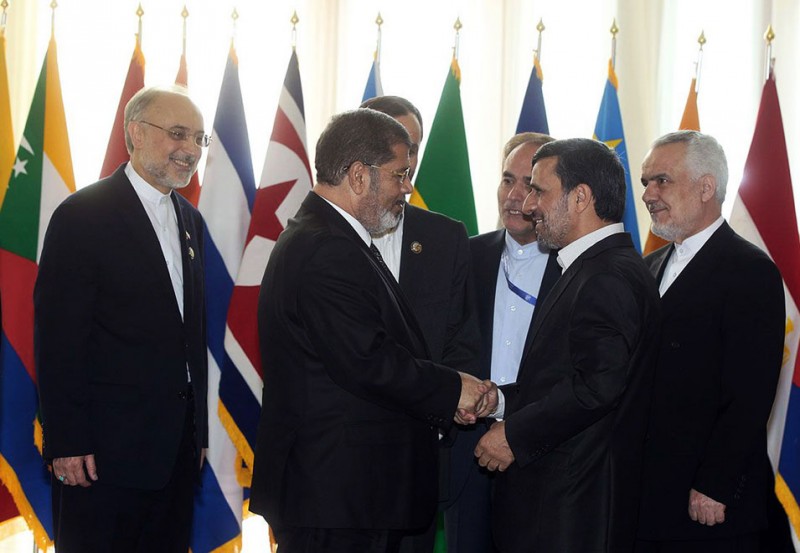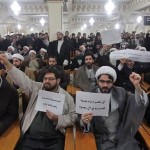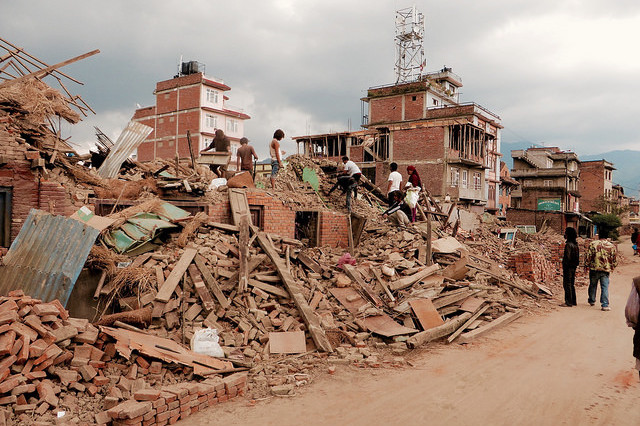by Richard Javad Heydarian
After three decades of frosty relations, President Mahmoud Ahmadinejad made a historic visit to Cairo on 5 February 2012, making him the only post-revolutionary Iranian leader to set foot in the Arab heartland. His trip marked the culmination of at least three years of gradual warming up between the two regional heavyweights — a trend that has accelerated since the downfall of Hosni Mubarak.
Ahmadinejad’s trip came at a particularly difficult time for Iran, as the Shiite-majority country faces growing isolation over its nuclear program and staunch support for the Alawite regime in Damascus. Confronting the prospects of a region-wide sectarian conflict as well as internal economic conflagration, Tehran has been more than eager to expand its ties with the emerging Islamist regime in Cairo. In addition to earlier talks about large-scale energy deals, Ahmadinejad went as far as offering a “big credit-line/loan” as well as a “visa-waiver” to his Arab host.
Banking on President Mohammad Morsi’s (perceived) maverick credentials, Tehran has hoped to achieve four main goals by reaching out to Cairo: form a new ‘axis of resistance’ in the region; favorably resolve the Syrian crisis; find a new interlocutor with the West and the greater Arab world; and tap into Egypt’s energy-starved economy. Iran, however, also faces a whole host of obstacles en route to its vision of a Tehran-Cairo duo.
The year 1979 marked a decisive year in Iran-Egypt relations, as a new revolutionary regime in Tehran went head-to-head with Egypt over the latter’s decision, under President Sadat, to enter into a peace treaty with Israel and host the deposed Shah of Iran. Shortly after the dissolution of bilateral diplomatic ties, Iran made a provocative decision to name one of its main streets after Sadat’s assassin, Khalid Islambouli.
When Hosni Mubarak took over, he quickly transformed Egypt into a regional anti-Iranian bulwark, supporting Saddam Hussein’s 8 years of destructive war against Iran and constantly thwarting Tehran’s regional maneuvers, especially in the Eastern Mediterranean. Yet, towards the end of his reign, Mubarak –- recognizing Iran’s regional influence and economic potentials – reciprocated Iranian efforts to mend bilateral ties. In late 2010, the two countries kicked off a series of diplomatic flirtations, which would intensify after Mubarak’s downfall. After three decades of cold war, they began discussing the resumption of direct flights between the two nations, while Egyptian political heavyweight and then-head of the Arab League, Amr Moussa, urged Arab countries to acknowledge the new geopolitical realities in the region, namely the rise of non-Arab countries such as Turkey and Iran — a position he would reiterate after the 2011 Egyptian Revolution. After Mubarak ousting, Egypt’s military junta — despite vehement opposition from Washington and Israel — marked another milestone in Iran-Egypt relations: It allowed Iranian warships to cross the Suez Canal. By this time, Iran’s diplomatic charm offensive was in full swing, with Iran’s Arab-speaking Foreign Minister Ali Akbar Salehi repeatedly exchanging cordial remarks with Egypt’s representatives, starting with former Egyptian Foreign Minister, Nabil El-Arabi,
Morsi’s ascent to power and his subsequent maneuvers to wrest control from the military and strike an independent tone on regional issues, further raised Iran’s hopes for a lasting partnership. In contrast to all Sunni powers, notably Turkey, Qatar, and Saudi Arabia, the new Egyptian leader decided to not only visit the Non-Aligned Movement (NAM) Summit in Tehran, but also (despite his harsh rhetoric against Assad) proposed a new Syria ‘Contact Group’ to include Iran as part of resolving the ongoing crisis. Later, Morsi would break with tradition by quickly jumping to Hamas’ rescue, to head off a prolonged crisis in Gaza. There were even reports of close Iran-Egypt security ties.
Prior to Ahmadinejad’s historic visit to Cairo, FM Salehi led a high profile trip, where he met top political and religious leaders in Cairo, in a bid to discuss Syria, project a post-sectarian Iranian image, and prepare the ground for Ahmadinejad’s visit. However, both Ahmadinejad and Salehi had to contend with the realities of Egypt-Iran relations. Egypt’s top religious figures and Salafi Islamist groups chided both Iranian leaders, in their separate visits, over Tehran’s support for Assad and the alleged marginalization of Sunni communities in Iran — underscoring the depth of the sectarian divide. With Saudi Arabia junking the Syria Contact Group, Morsi has also hardened his position on Syria, calling for regime change, much to Iran’s disappointment.
Given Qatar and Saudi Arabia’s huge offers of financial support to Egypt’s struggling economy, Morsi has remained silent on the Shiite democratic revolution in Bahrain, while demurring Iran’s earlier offers to hold the next round of nuclear talks in Cairo. Morsi is also in no mood to compromise crucial strategic relations with the US, which has not only provided billions in military economic aid (and possibly even debt relief), but also stubbornly stood by the embattled president amid the ongoing political crisis in Egypt.
Overall, Ahmadinejad was able to set a new milestone in bilateral relations by setting foot in the Arab heartland, a step which could mark the paving of a path toward normalized bilateral ties, but it still remains far from certain whether Iran can find a major strategic and economic partner in Egypt.
Photo: Egyptian President Mohamed Morsi shakes hands with Iranian President Mahmoud Ahmadinejad in Tehran during the Non-Aligned Movement Summit on 30 August 2012.





